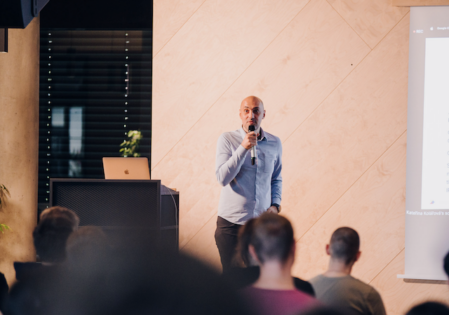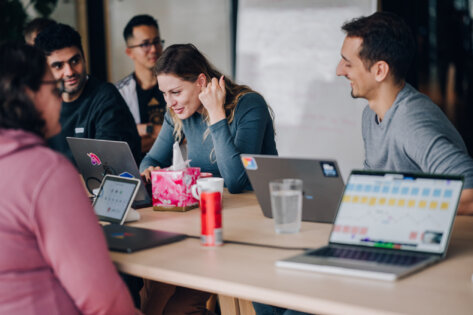Design at Productboard – an introduction to the design team

As we continue to grow at a rapid pace, we’re always on the lookout for talented new designers to join our team. We interview a lot of people in the process. And those people ask a lot of great questions.
In this series of articles, I’ll answer some of the most frequently asked questions we get asked. To kick off, I’ll discuss the design ethos here at Productboard, our team set-up, and some of the challenges we’re currently facing.
What is the role of design at Productboard? How is design perceived?
Whenever I’m asked this question during interviews, I tell candidates about Productboard’s first employee, Majo – the first person to join our founders, Hubert and Dan. Majo was a designer, which speaks volumes about the importance of design at Productboard from the very beginning.
The founders realized they needed somebody to materialize their vision and help them explore the possibilities and pathways they could take with the product. They didn’t hire 10 engineers at first. They went with a designer.
When I joined almost four years ago, there were about 20 people in the company, and I was the third designer. That was unheard of at the time – often you would have one designer per 20, 50, or even 100 engineers.
Today, the design team keeps growing. We’re now over 20 people. Our head of design is part of the senior leadership group, giving the design a seat at the table.
Everybody knows that design is central to the company’s ongoing success. Everybody understands that to further build out the product, we need teams, and a team isn’t complete if it doesn’t have a designer. So every single product team at Productboard has a dedicated designer.
When we talk to the founders, director of product management, or engineers, we don’t talk over documents and written words. Language is ambiguous. We always talk over prototypes, drawings, and pictures. We ask, what is this new functionality going to look like? What is the flow going to look like? How is it going to feel? How is it going to work inside of Productboard?
“We always start with customer problems. We draw the future. Then we talk about it. Then we validate with customers. Once we’ve checked all the boxes, we go and describe it. So our engineers – who we involve early in the process – know what to build. That’s the role of design here at Productboard.”
What is the team setup?
At Productboard, every designer is embedded in a product team, which is part of a tribe, and that tribe is part of the whole EPD (engineering, product, design) organization. And then next to EPD, you have sales, customer support, and other functions.
Product teams usually include a product manager, a designer, a few engineers, and maybe a QA person, writer, or data engineer, depending on what kind of team it is. There are several product teams within each tribe.
We currently have four tribes at Productboard: Insights, PnR (which stands for prioritization and roadmaps), Scale, and Growth. We’ll also be adding another tribe soon around Customer Intelligence.
What does each tribe do?
Growth is responsible for providing an outstanding customer experience during trials and onboarding. They also provide in-product customer expansion motions, helping existing customers to get even more value from Productboard.
The Insights tribe helps organizations understand their customers and make the best decisions about what to build next. This process revolves around a three-step learning loop, where organizations are empowered to collect, understand, and take action on customer feedback.
PnR, as the name suggests, is all about prioritization and roadmaps. Its mission is to make Productboard the place where products – and the roadmaps and strategies behind them – get built and teams align around them.
Scale’s mission is to ensure that companies of all sizes can use Productboard as seamlessly as possible. They are also tasked with expanding the Productboard ecosystem through integrations and APIs.
Finally, our latest tribe, Customer Intel, is responsible for building a bridge between product managers and customer-facing teams. The aim is to allow customer-facing teams to access and act upon relevant customer data in Productboard, as customer-centricity is the core of our existence.

What are the main challenges facing the design team today?
Scaling brings so many challenges. How do we maintain our culture while expanding at a rapid pace? How do we update processes and rituals as teams grow? How do we continue to collaborate across teams, tribes, and departments, and avoid silos? These are all questions we’re answering as we go.
From a design perspective, we have this big company that’s growing all the time, but we’re building just one product. Everybody is touching the same thing. There are lots of overlaps and dependencies. If I’m trying to improve this one thing, there’s probably another team trying to improve something that’s closely related. So those two teams have to be speaking and working together. You have to align everyone, and things can move a little slower.
We’ve been adding so many new faces, and it’s important that people build relationships and understand where others are coming from. With COVID, people couldn’t travel for the past few years. Collaboration becomes difficult when you just don’t know who you are talking to. When the other person who’s giving you feedback is just a face on Zoom or a name on Slack, and you have no idea who they really are. But that’s not unique to Productboard.
In part two of this series, I’ll discuss how we work, focussing on the important matters of collaboration and feedback.
I hope this article provided as much clarity as possible and gave you a taste of what life is like as a Productboard designer.
If you liked what you heard, why not head over to our careers page and check out the latest openings? If you’re a passionate and talented designer looking for an exciting new challenge, we’d love to hear from you.







